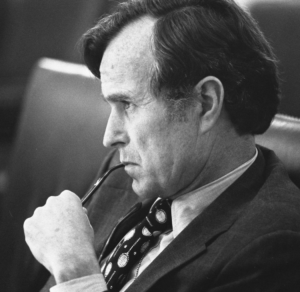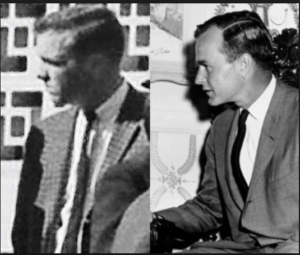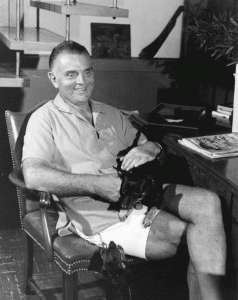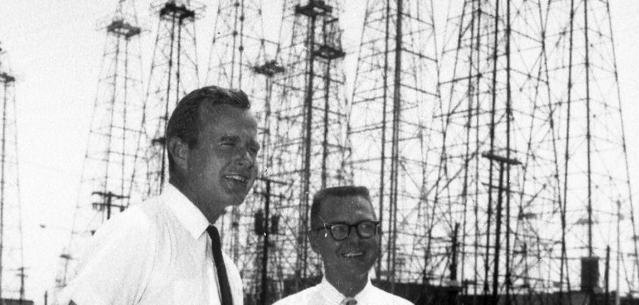
As editor of the JFK Facts blog, I often heard the theory that the late President Bush was somehow complicit in JFK’s death. In the comments section of site, it was a hardy perennial.
Exactly how Bush was involved was rarely explained.
To me it seemed that JFK conspiracy theories about Bush persisted mainly as a way of criticizing the politics and policies of the 41st president and his son, the 43rd president. They were only secondarily about what happened in Dallas on November 22, 1963.
I’m no fan of the Bush family’s policies and politics. Father and son were men of power and capable of terrible things, even worse than political assassination. But on the JFK story, I see no evidence of malfeasance.
Four Claims
Four claims are adduced to support the “Bush done it” theory:
1) An FBI memo from November 1963, which says that “George Bush of the Central Intelligence Agency” was orally advised by an FBI official about the reaction of Cuban Miami to JFK’s assassination.
2) Bush’s improbable statement, quoted in Kitty Kelly’s biography, that he couldn’t recall where he was when JFK was killed;
3) Photographic imagery of a person purported to be Bush in Dealey Plaza;
4) A 1976 letter to Bush from George de Mohrenschildt, an itinerant geologist who did favors for the CIA and who knew Lee Oswald in 1963.
Let’s consider these in turn.
‘Bush of the CIA’
On November 29, 1963, a week after the assassination of President Kennedy, an FBI official told the State Department that “Mr. George Bush of the Central Intelligence Agency” had been given a briefing on the reaction of Cuban exiles in Miami to JFK’s assassination.
[Read the memo: “George Bush of the Central Intelligence Agency”]
When the memo surfaced in the 1988 presidential campaign, the CIA took the rare step of commenting publicly. The agency claimed that the document referred to another CIA employee named George Williams Bush.
That, alas, was a cover story, and a brittle one. The former employee came forward and stated, under oath “I am not the George Bush of the Central Intelligence Agency referred to in the memorandum.”
So it is fair to conclude the FBI memo of November 1963 does refer to George H.W. Bush, the man who would become CIA director and president.
So what?
If it is true that Bush had some association with the CIA in 1963–and I think he did–that does not constitute evidence of anything about JFK’s assassination. It constitutes evidence that Bush was associated with the CIA and communicated with the FBI. For a conservative Texas oil entrepreneur backed by Wall Street money that is noteworthy but not surprising. It is not necessarily suspicious.
Amnesia
Bush’s inability to remember where he was on November 22–if accurately reported by Kitty Kelly, not the most reliable of sources–is curious. It suggests Bush was not comfortable talking about JFK’s assassination. It raises the possibility that he might have had guilty knowledge about what President Nixon called “the whole Bay of Pigs thing.”
Bush’s oil drilling firm had worked with the CIA operative in the run-up the disastrous Bay of Pigs invasion that failed to overthrow Castro. He knew the resentment in conservatives and Cuban exiles about JFK’s peaceful resolution of the missile crisis.
But, of course, his selective amnesia could have other sources too.
Bush’s whereabouts on November 22, 1963 are known. He spoke at an oil industry meeting on the evening of November 21. The next day he flew to Tyler, Texas, for an appearance in his Senate campaign. At some point he spoke to the FBI about a local man who had threatened JFK.
How exactly does this set of facts indicate involvement in a murder conspiracy? It doesn’t.
One can speculate that Bush’s report to the FBI was a cover story to hide his real whereabouts. Maybe it was. It just as possible that it wasn’t. Speculation, however plausible, isn’t evidence.
Dealey Plaza Look-Alike?

The purported photographic evidence of Bush in Dealey Plaza is vanishingly weak.
Verification analysis would do comparative measurements of the nose, eyebrows and chin of the men seen in the photographs. I don’t know that anyone has undertaken this elementary investigative step.
Without empirical data, I would say differences between the two men are fairly apparent. Without corroborating evidence, the purported identification fails.
Recall too the circumstances. In November 1963, Bush had been an announced candidate for U.S. Senate for several months. He was known as the son of a Yankee senator. He had been the subject of numerous newspaper articles. There were hundreds of people watching the presidential motorcade pass through Dealey Plaza.
Not a single witness recalled seeing the dashing Ivy League oil man who was running against popular liberal incumbent Senator Ralph Yarborough–even Yarborough was passing by in the presidential motorcade.
If Bush was in Dealey Plaza that day, how likely is that not a single person noted the presence of two senatorial rivals. It is highly unlikely. There’s no credible evidence: he was at the crime scene.
The Letter

The letter from George DeMohrenschildt to CIA director Bush, dated September 1976, is important and noteworthy. DeMohrenschildt was one of Lee Harvey Oswald’s best friends in Dallas in 1962-6
By 1976, the itinerant geologist no longer believed that Oswald had killed JFK. He wrote a cogent manuscript (recently published by the University Press of Kansas) asserting that Oswald was “a patsy” for other people who killed Kennedy.
In the fall of 1976. DeMohrenschildt was under pressure from congressional investigators to tell what he knew–which was a lot. In distress, he wrote to his friend at the CIA, George Bush.
Bush acknowledged that he knew de Mohrenschildt, which corroborates de Mohrenschildt’s account of his close relations to the CIA. But the letter is not evidence of either man’s involvement in a JFK conspiracy.
The letter is evidence that DeMohrenschildt was worried about saying, under oath, that Oswald was innocent. He had cooperated with the CIA for years and didn’t want to put himself at odds with the agency. Bush chose not to respond the letter, deflected him politely, evidence he didn’t want to get involved.
Six months later, DeMohrenschildt committed suicide.
The letter shows that Bush was cold-blooded to an acquaintance when it suited his purposes. It shows as director he wasn’t interesting in questioning the agency’s CIA’s dubious account of JFK’s death.
The letter does not show Bush was complicit in JFK’s assassination. It does show he was complicit in the JFK coverup, which continues to this day.
Postscript
In March 2013, I wrote on JFK Facts that the “Bush done it” conspiracy theory was “quasi-libelous.” I said “quasi” because the former president, as a living public figure, effectively could not be libeled under U.S. law.
I wrote “libelous” because the allegation struck me as so weak and defamatory as to qualify as to be libelous in an ethical, if not a legal, sense. It resembles the bogus JFK conspiracy theory, based on a photograph, that Donald Trump used to smear Ted Cruz.
Now that Bush has passed, libel is no longer an issue, only the historical truth. And the truth is that there is no credible evidence that Bush was involved in JFK’s assassination.
I think JFK Facts reader Bill Pierce had the right take on such speculations.
“Yes, there are lots of fascinating, ominous, backbiting, double-crossing and mutually beneficial interrelationships among powerful people. And there are lots of supportable reasons to ‘believe’ that the listed individuals and hundreds of other powerful people (and hate groups) strongly disagreed with the Kennedys’ policies and personalities. Maybe all of them wanted JFK murdered. Maybe Joe DiMaggio and Arthur Miller planned the execution because they were jealous about Marilyn’s sexy birthday song to JFK. Maybe . . . but there’s no evidence to support it.”



